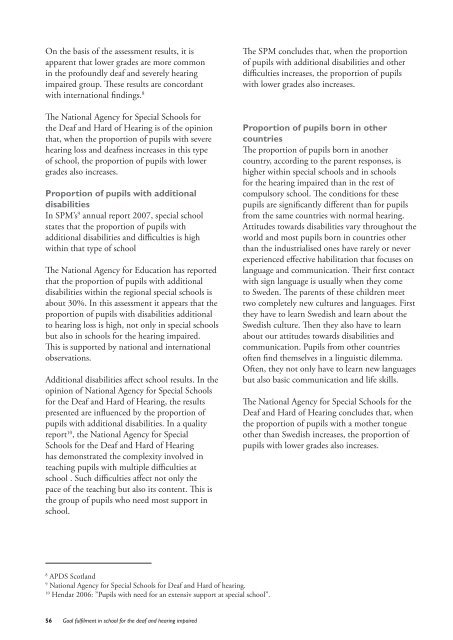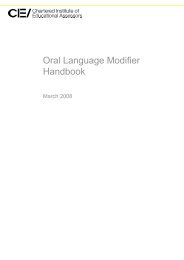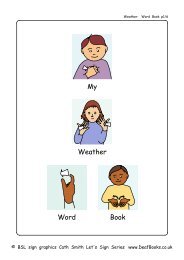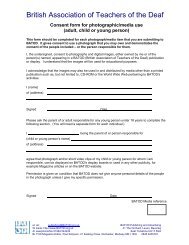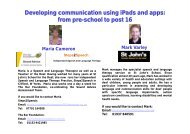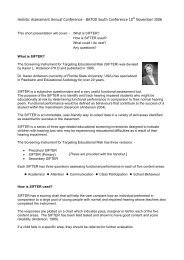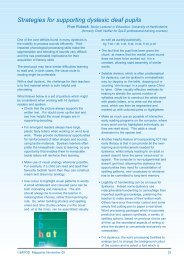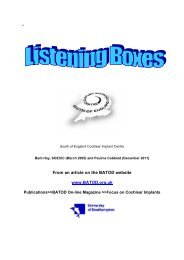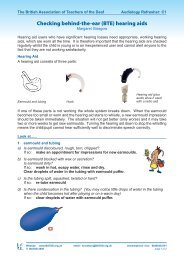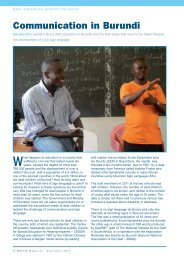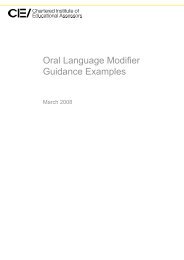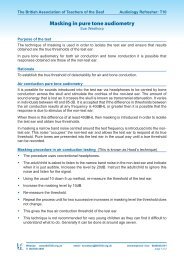Goal fulfilment in school for the deaf and hearing impaired - batod
Goal fulfilment in school for the deaf and hearing impaired - batod
Goal fulfilment in school for the deaf and hearing impaired - batod
- No tags were found...
Create successful ePaper yourself
Turn your PDF publications into a flip-book with our unique Google optimized e-Paper software.
On <strong>the</strong> basis of <strong>the</strong> assessment results, it isapparent that lower grades are more common<strong>in</strong> <strong>the</strong> profoundly <strong>deaf</strong> <strong>and</strong> severely hear<strong>in</strong>g<strong>impaired</strong> group. These results are concordantwith <strong>in</strong>ternational f<strong>in</strong>d<strong>in</strong>gs. 8The National Agency <strong>for</strong> Special Schools <strong>for</strong><strong>the</strong> Deaf <strong>and</strong> Hard of Hear<strong>in</strong>g is of <strong>the</strong> op<strong>in</strong>ionthat, when <strong>the</strong> proportion of pupils with severehear<strong>in</strong>g loss <strong>and</strong> <strong>deaf</strong>ness <strong>in</strong>creases <strong>in</strong> this typeof <strong>school</strong>, <strong>the</strong> proportion of pupils with lowergrades also <strong>in</strong>creases.Proportion of pupils with additionaldisabilitiesIn SPM’s 9 annual report 2007, special <strong>school</strong>states that <strong>the</strong> proportion of pupils withadditional disabilities <strong>and</strong> difficulties is highwith<strong>in</strong> that type of <strong>school</strong>The National Agency <strong>for</strong> Education has reportedthat <strong>the</strong> proportion of pupils with additionaldisabilities with<strong>in</strong> <strong>the</strong> regional special <strong>school</strong>s isabout 30%. In this assessment it appears that <strong>the</strong>proportion of pupils with disabilities additionalto hear<strong>in</strong>g loss is high, not only <strong>in</strong> special <strong>school</strong>sbut also <strong>in</strong> <strong>school</strong>s <strong>for</strong> <strong>the</strong> hear<strong>in</strong>g <strong>impaired</strong>.This is supported by national <strong>and</strong> <strong>in</strong>ternationalobservations.Additional disabilities affect <strong>school</strong> results. In <strong>the</strong>op<strong>in</strong>ion of National Agency <strong>for</strong> Special Schools<strong>for</strong> <strong>the</strong> Deaf <strong>and</strong> Hard of Hear<strong>in</strong>g, <strong>the</strong> resultspresented are <strong>in</strong>fluenced by <strong>the</strong> proportion ofpupils with additional disabilities. In a qualityreport 10 , <strong>the</strong> National Agency <strong>for</strong> SpecialSchools <strong>for</strong> <strong>the</strong> Deaf <strong>and</strong> Hard of Hear<strong>in</strong>ghas demonstrated <strong>the</strong> complexity <strong>in</strong>volved <strong>in</strong>teach<strong>in</strong>g pupils with multiple difficulties at<strong>school</strong> . Such difficulties affect not only <strong>the</strong>pace of <strong>the</strong> teach<strong>in</strong>g but also its content. This is<strong>the</strong> group of pupils who need most support <strong>in</strong><strong>school</strong>.The SPM concludes that, when <strong>the</strong> proportionof pupils with additional disabilities <strong>and</strong> o<strong>the</strong>rdifficulties <strong>in</strong>creases, <strong>the</strong> proportion of pupilswith lower grades also <strong>in</strong>creases.Proportion of pupils born <strong>in</strong> o<strong>the</strong>rcountriesThe proportion of pupils born <strong>in</strong> ano<strong>the</strong>rcountry, accord<strong>in</strong>g to <strong>the</strong> parent responses, ishigher with<strong>in</strong> special <strong>school</strong>s <strong>and</strong> <strong>in</strong> <strong>school</strong>s<strong>for</strong> <strong>the</strong> hear<strong>in</strong>g <strong>impaired</strong> than <strong>in</strong> <strong>the</strong> rest ofcompulsory <strong>school</strong>. The conditions <strong>for</strong> <strong>the</strong>sepupils are significantly different than <strong>for</strong> pupilsfrom <strong>the</strong> same countries with normal hear<strong>in</strong>g.Attitudes towards disabilities vary throughout <strong>the</strong>world <strong>and</strong> most pupils born <strong>in</strong> countries o<strong>the</strong>rthan <strong>the</strong> <strong>in</strong>dustrialised ones have rarely or neverexperienced effective habilitation that focuses onlanguage <strong>and</strong> communication. Their first contactwith sign language is usually when <strong>the</strong>y cometo Sweden. The parents of <strong>the</strong>se children meettwo completely new cultures <strong>and</strong> languages. First<strong>the</strong>y have to learn Swedish <strong>and</strong> learn about <strong>the</strong>Swedish culture. Then <strong>the</strong>y also have to learnabout our attitudes towards disabilities <strong>and</strong>communication. Pupils from o<strong>the</strong>r countriesoften f<strong>in</strong>d <strong>the</strong>mselves <strong>in</strong> a l<strong>in</strong>guistic dilemma.Often, <strong>the</strong>y not only have to learn new languagesbut also basic communication <strong>and</strong> life skills.The National Agency <strong>for</strong> Special Schools <strong>for</strong> <strong>the</strong>Deaf <strong>and</strong> Hard of Hear<strong>in</strong>g concludes that, when<strong>the</strong> proportion of pupils with a mo<strong>the</strong>r tongueo<strong>the</strong>r than Swedish <strong>in</strong>creases, <strong>the</strong> proportion ofpupils with lower grades also <strong>in</strong>creases.8APDS Scotl<strong>and</strong>9National Agency <strong>for</strong> Special Schools <strong>for</strong> Deaf <strong>and</strong> Hard of hear<strong>in</strong>g.10Hendar 2006: ”Pupils with need <strong>for</strong> an extensiv support at special <strong>school</strong>”.56 <strong>Goal</strong> <strong>fulfilment</strong> <strong>in</strong> <strong>school</strong> <strong>for</strong> <strong>the</strong> <strong>deaf</strong> <strong>and</strong> hear<strong>in</strong>g <strong>impaired</strong>


